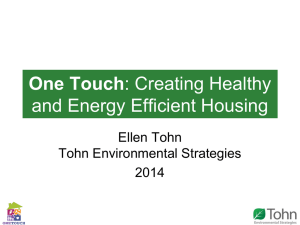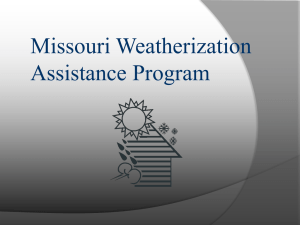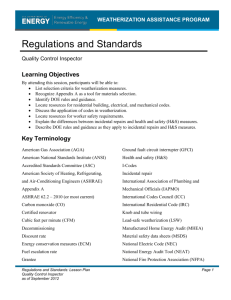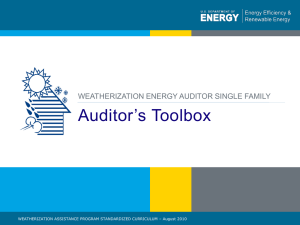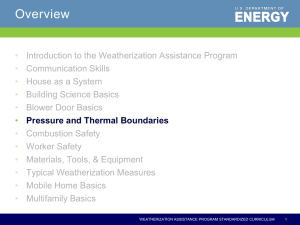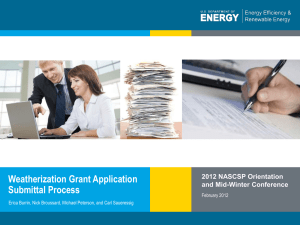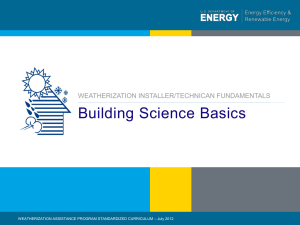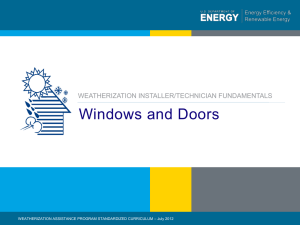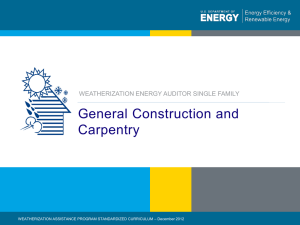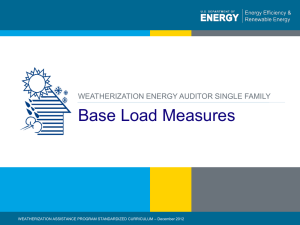Introduction to Weatherization for Quality Control Inspectors
advertisement
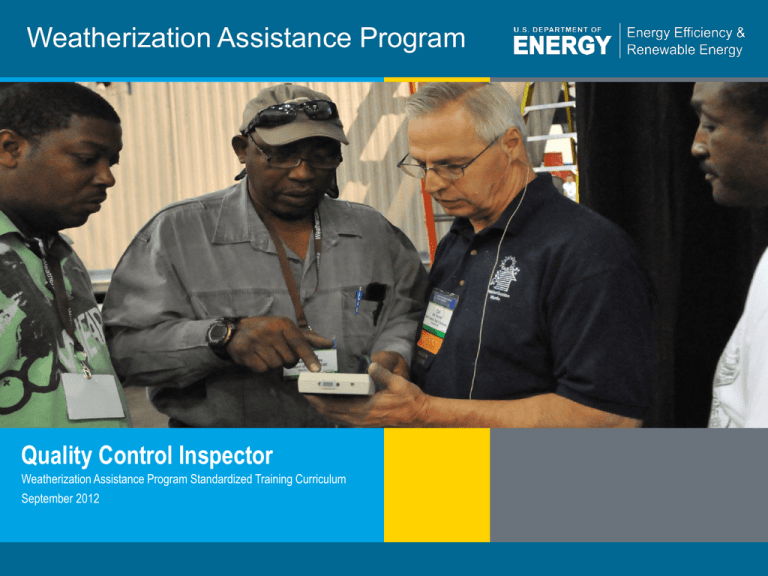
Weatherization Assistance Program Quality Control Inspector Weatherization Assistance Program Standardized Training Curriculum September 2012 1 | WEATHERIZATION ASSISTANCE PROGRAM STANDARDIZED CURRICULUM – September 2012 eere.energy.gov QUALITY CONTROL INSPECTOR Introduction to Weatherization WEATHERIZATION ASSISTANCE PROGRAM STANDARDIZED CURRICULUM – September 2012 2 | WEATHERIZATION ASSISTANCE PROGRAM STANDARDIZED CURRICULUM – September 2012 eere.energy.gov Learning Objectives INTRODUCTION TO WEATHERIZATION By attending this session, participants will be able to: • Discuss the historical perspective of the Weatherization Assistance Program (WAP). • Name characteristics of the client base served by the program. • Recognize that building science guides the selection of measures installed with program dollars. • Describe the principles of cost-effectiveness and the savings-to-investment ratio (SIR). • Recognize modern weatherization measures. 3 | WEATHERIZATION ASSISTANCE PROGRAM STANDARDIZED CURRICULUM – September 2012 eere.energy.gov Mission INTRODUCTION TO WEATHERIZATION Mission of the Weatherization Assistance Program To reduce energy costs for low-income families, particularly for the elderly, people with disabilities, and people with children, while ensuring their health and safety. 4 | WEATHERIZATION ASSISTANCE PROGRAM STANDARDIZED CURRICULUM – September 2012 eere.energy.gov Organization INTRODUCTION TO WEATHERIZATION Organization: The Team Approach U.S. Department of Energy Headquarters and the project management centers (NETL and Golden) 50 state energy offices, the District of Columbia, Native American tribal organizations, and five territories Over 900 local agencies 5 | WEATHERIZATION ASSISTANCE PROGRAM STANDARDIZED CURRICULUM – September 2012 Low-income households eere.energy.gov Weatherization Process INTRODUCTION TO WEATHERIZATION Wx Program Promotion and Client Recruitment Wx Program Intake and Eligibility Determination Contractor/Crew Final Inspection Work Scope Implementation/In stallation Agency Final Inspection Client follow-up Applicant Selection and Preparation Auditor Background Familiarization Work Scope Development Initial Site Visit – Auditor Conducts Energy Audit, H&S Testing,… Possible State and/or Federal Monitoring Visit 6 | WEATHERIZATION ASSISTANCE PROGRAM STANDARDIZED CURRICULUM – September 2012 eere.energy.gov Low-Income Households INTRODUCTION TO WEATHERIZATION Characteristics of Low-Income Households • More than 90% of low-income households have annual incomes less than $15,000. • More than 13% of these low-income households have annual incomes less than $2,000. • According to DOE’s Energy Information Administration (EIA), low-income households spend 14.4% of their annual income on energy, while other households only spend 3.3%. • The average energy expenditures in low-income households is $1,800 annually (as of 2010). • The elderly occupy 34% of low-income homes. 7 | WEATHERIZATION ASSISTANCE PROGRAM STANDARDIZED CURRICULUM – September 2012 eere.energy.gov History INTRODUCTION TO WEATHERIZATION 1976 to Early 1980s (First Generation) • Started in Maine as “Winterization” • Administered by the Community Services Administration • Later managed by the Federal Energy Administration • Volunteer labor • Low-cost measures • Little or no accountability 8 | WEATHERIZATION ASSISTANCE PROGRAM STANDARDIZED CURRICULUM – September 2012 eere.energy.gov History INTRODUCTION TO WEATHERIZATION Early 1980s to Late 1980s (Second Generation) • Used volunteer labor from the Comprehensive Employment & Training Act under the Department of Labor • Often installed temporary measures • Little or no diagnostic technology • Project Retro-Tech – A paper energy audit allowed entry of the areas and R-values in the home to do very basic heat transfer calculations • Addressed the building envelope • WAP’s “Blow and go” – Program for attics that completed houses quickly, but with much less improvement than is common today 9 | WEATHERIZATION ASSISTANCE PROGRAM STANDARDIZED CURRICULUM – September 2012 eere.energy.gov History INTRODUCTION TO WEATHERIZATION 1990s (Third Generation) • Used paid professional labor • Addressed both building envelope and mechanical heating systems • Diagnostic tools used in some states • Various components of program computerized • State and national evaluations conducted • Structured training and technical assistance provided 10 | WEATHERIZATION ASSISTANCE PROGRAM STANDARDIZED CURRICULUM – September 2012 eere.energy.gov History INTRODUCTION TO WEATHERIZATION 1990s to Present (Fourth Generation) • Measures are permanent and cost effective • Rental plans to ensure that weatherization benefits, i.e., savings on utility bills, accrue to tenants, not landlords • Health and safety plans that establish protocols for energy-related health and safety measures, like relining chimneys or replacing faulty furnaces • Increased use of advanced diagnostic tools and energy audits • States leverage funds from other Federal programs and often through utilities to expand the reach of their WAP • Coordination with the U.S. Department of Housing and Urban Development’s (HUD) housing agencies make comprehensive rehabilitation and weatherization possible 11 | WEATHERIZATION ASSISTANCE PROGRAM STANDARDIZED CURRICULUM – September 2012 eere.energy.gov Measures INTRODUCTION TO WEATHERIZATION “Old School” Weatherization Measures Many weatherization programs without strong management, turned into “doors and windows” programs that often included: • Replacing windows. • Adding storm windows. • Replacing doors. • Adding weather stripping. • Adding some attic insulation. • Caulking (by the case). Doors and windows especially are highly visible and get much publicity, but typically they aren’t cost-effective. The measures that save the most energy – air sealing and adding insulation – are largely invisible. 12 | WEATHERIZATION ASSISTANCE PROGRAM STANDARDIZED CURRICULUM – September 2012 eere.energy.gov Measures INTRODUCTION TO WEATHERIZATION Modern Weatherization Measures • Blower door-directed air sealing • Duct sealing and modification • Attic insulation • Electric base load measures: • Dense-pack sidewall insulation o Compact fluorescent light bulbs (CFLs) • Heating and cooling equipment repair and replacement o Refrigerator replacement o Water heater modification and replacement 13 | WEATHERIZATION ASSISTANCE PROGRAM STANDARDIZED CURRICULUM – September 2012 eere.energy.gov Results INTRODUCTION TO WEATHERIZATION • Almost 7 million homes have been weatherized to date with Federal and leveraged funds such as state and utility monies and fuel assistance program funds. • Energy savings averages 35% of consumption for a typical low-income home. • A favorable benefit-cost ratio of 1.8:1 exists. • The program supports tens of thousands of direct and indirect jobs nationwide. 14 | WEATHERIZATION ASSISTANCE PROGRAM STANDARDIZED CURRICULUM – September 2012 eere.energy.gov Cost-Effectiveness INTRODUCTION TO WEATHERIZATION Cost-Effectiveness Requirements • An SIR of 1 or higher • Energy-related health and safety work not included in the SIR • No federally mandated upper limit for health and safety (H&S) funds • Higher requests for H&S budgets can encourage increased scrutiny of the state plan • SIR ≥ 1: The measure pays for itself over its lifetime 15 | WEATHERIZATION ASSISTANCE PROGRAM STANDARDIZED CURRICULUM – September 2012 eere.energy.gov Cost-Effectiveness INTRODUCTION TO WEATHERIZATION States may include overhead costs in their costeffectiveness requirements, but this limits the weatherization measures that can be cost-effectively done to the house. 16 | WEATHERIZATION ASSISTANCE PROGRAM STANDARDIZED CURRICULUM – September 2012 eere.energy.gov Typical Savings & Payback INTRODUCTION TO WEATHERIZATION TYPICAL MEASURES INSTALLED ENERGY SAVINGS PAYBACK PERIOD Virginia homes weatherized July 1988 to June 1989 • Caulking • Weatherstripping • Replacement windows • Storm windows • Attic insulation Single family – Gas heat………...10% Single family – Electric heat………5% Mobile homes…………………….10% 30 years 21 years 53 years Virginia homes weatherized July 1989 to June 1990 • Advanced air sealing • Attic insulation • High-density wall insulation • Heating safety and efficiency improvements Single family – Site built…………24% Mobile homes…………………….17% 17 | WEATHERIZATION ASSISTANCE PROGRAM STANDARDIZED CURRICULUM – September 2012 10 years 17 years eere.energy.gov Summary INTRODUCTION TO WEATHERIZATION • The mission of WAP is to reduce the energy bills of low- to moderate-income households. • Clients typically have a high energy burden. • Modern weatherization measures are based on principles of building science and cost-effectiveness. • There are limits on spending for incidental repairs, but not for health and safety measures. • National evaluation in the early 1990s determined program is effective at energy use reduction and jobs creation. 18 | WEATHERIZATION ASSISTANCE PROGRAM STANDARDIZED CURRICULUM – September 2012 eere.energy.gov
